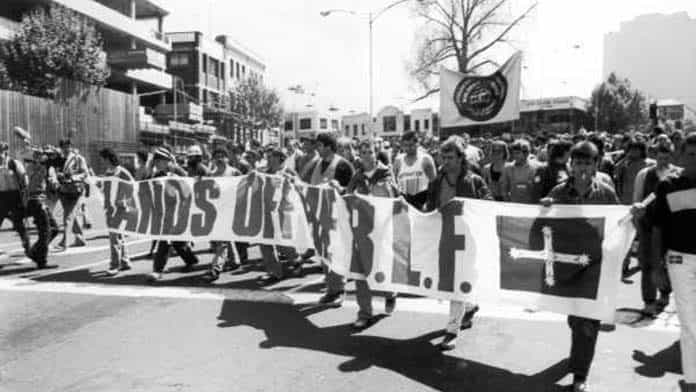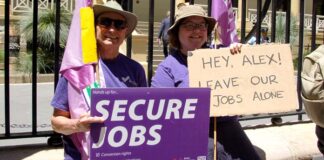There are lessons for the CFMEU today from the way Labor succeeded in breaking the Builders’ Labourers Federation in 1986, argues Tom Orsag
The offensive against the militant Construction Division of the CFMEU is backed by an unholy alliance of the mainstream media, the Labor Government and the ACTU.
This is far from the first time the construction union has faced such a concerted attack.
Recent Liberal governments have launched two costly Royal Commissions into the union, in 2001 and 2014. The second of them, explicitly tasked with investigating union corruption at a cost of $46 million, uncovered just two instances of possible corruption by CFMEU officials.
The Liberals also set up the Australian Building and Construction Commission to investigate and harass construction workers. But the main aim has always been to frustrate legitimate union activity and do the bidding of the construction company bosses.
The Albanese government’s orders to the anti-union Fair Work Commissioner to have administrators take over four state branches of the union is far more sweeping—and could do far more damage.
There is a clear parallel with Labor Prime Minister Bob Hawke’s deregistration of the Builders’ Labourers Federation in 1986—a ruthless effort at union busting that broke the union.
Hawke and the BLF
Hawke’s offensive against the BLF showed that Labor was prepared to stage a ruthless attack on the unions.
The BLF had been too successful for its members, winning wage rises, shorter hours and safer working conditions.
The union also had a proud record of support for Aboriginal rights and the environment, made famous through its Green Bans in NSW in the 1970s.
BLF organisers were also willing to risk arrest for defying the courts and anti-union laws, and BLF members willing to strike until they were released.
The targeting of the BLF began with a Royal Commission under Malcolm Fraser’s Liberal government in 1981. It finally discovered that BLF Secretary Norm Gallagher had accepted $100,000 in building materials for his beach house. The evidence against him was flimsy, but Gallagher eventually went to jail for corruption.
It was the BLF’s opposition to the Hawke Government’s “Prices and Incomes Accord” which finally led to its deregistration, the use of anti-union laws and police violence to shut it down.
The Accord was an agreement between the peak union body, the ACTU, and the Labor Party implemented after Labor came to office in March 1983.
The union movement agreed to accept a cap on wage rises in return for supposed increases in “the social wage”—increased funding for education, health and welfare.
In reality, it was a plan designed to cut wages and curb union power in order to restore profits for the bosses after the recessions of 1974 and 1982. The Accord imposed wage cuts of about 7.5 per cent in the first five years of the Labor government.
The Accord was endorsed at the 1983 ACTU Conference with only the NSW nurses union voting against. The BLF’s leader, Norm Gallagher, had doubts but refused to raise them publicly.
When the economy began to recover from recession in 1984-85, the BLF began a series of industrial campaigns for pay rises above the Accord limits.
This was too much for the Labor government. The Accord was central to its plan for the health of Australian capitalism.
Long-term media commentator, Max Walsh, noted, “Hawke and company know that they’re going to have to crush the BLF…for the preservation of the Hawke government [they] decided the BLF has to go.”
In July 1985, Hawke told Cabinet unabashedly, “We’re gonna smash those bastards. We’re going to deregister the BLF.”
The Financial Review gloated that, “The Hawke government has become a jailer for unions which dare to buck the Accord consensus, and the ACTU has become an industrial police force.”
The Federal Government and the two state Labor governments drew up Codes of Conduct for building companies to stop them dealing with the BLF or paying above Award wages in so-called “sweetheart deals.”
Building companies who refused to sign the Codes faced the loss of Federal and state government work.
In Victoria, Premier John Cain threatened to hold up planning permits and cut off gas, electricity and water to building sites in order to enforce the state Code.
To eliminate any doubt it was an orchestrated plan, Clive Bubb, CEO of Master Builders Australia said, “This is a fully coordinated, carefully structured, national campaign dedicated to ridding our $15 billion a year industry of the BLF blight.”
But the BLF did not appreciate how far the ACTU and the Labor Party were willing to go. Even as deregistration took effect Norm Gallagher was playing down the threat, saying, “We will look after ourselves, just wait and see”.
Smashing the union
In 1986, the BLF was deregistered federally and in NSW, Victoria and the ACT, then its areas of largest membership.
This meant it was banned from striking agreements with employers and lost the right to appear in industrial courts to represent its members.
Prime Minister Bob Hawke passed laws against it in the Federal Parliament. Simultaneous laws were introduced by State Premiers in NSW and Victoria.
The government used the full force of the law, the courts and the police to break the union.
Key BLF organisers like Victoria’s John Cummins were banned from building sites and then arrested and jailed for six nights for “trespassing” when they tried to enter.
Steve Crabb, then Victorian Minister for Industrial Relations, set in motion police raids on the BLF offices to confiscate its membership list and the union funds.
The union had been deregistered before between 1974 and 1976 and had survived, even increasing its membership during the period.
This happened under a Liberal government, so the ACTU supported the union and the wider union movement refused to poach BLF members.
In 1986, with the ACTU backing the Accord, the logic of protecting the Labor government meant it instead joined the assault on the BLF. The ACTU’s support was the key to smashing the BLF.
Rival unions the Building Workers’ Industrial Union (BWIU) and FEDFA, the crane drivers’ union, agreed to poach the BLF’s membership.
Large contingents of police moved onto building sites around Sydney, Melbourne and Canberra to help employers and union organisers intimidate rank-and-file BLF members into joining the BWIU.
Workers were told to either quit the BLF or lose their jobs. Some were even locked in sheds on sites until they agreed.
This was all the more appalling as the BWIU had a reputation as a left-wing union, led in NSW by former Communist Party members Tom McDonald and Pat Clancy and in the National Office by Stan Sharkey.
With the ACTU shamefully approving the efforts to break the union, and even left-wing unions doing nothing to defend it, the BLF was smashed.
Many BLF supporters in Victoria continued to maintain BLF membership alongside that of other unions and held out as long as they could on some stalwart sites, like 417 St Kilda Rd.
In 1993 what was left of the BLF amalgamated with the BWIU into the new super union, the CFMEU. Former BLF organisers like John Cummins and John Setka and stalwarts like Ralph Edwards would go on to play important roles in the new CFMEU.
Disgracefully, the ACTU is again supporting the Labor government’s attack on the CFMEU today.
This time the government has decided to appoint administrators to take over CFMEU branches instead of deregistering the union completely.
But this is no sign that it intends to go easy on it. Elected officials are facing the sack. The talk of cancelling some CFMEU Enterprise Bargaining Agreements could be used to push the union out of government-funded construction projects. The AWU already has coverage of some government projects in Queensland, and would be happy to poach CFMEU members.
A long process of administration could also set the stage for installing new, more conservative officials to run the union after fresh union elections.
Labor then and now
The Labor Party was founded by unions to represent their interests in parliament. Yet it was Labor Prime Minister Bob Hawke who set out to break the BLF. This was a lesson in how far Labor is prepared to go to defend capitalism and serve the interests of the bosses—and should be a warning for the CFMEU today.
Victorian Labor Premier John Cain even boasted that in regards to the BLF, “I have always said only a Labor government can do what we are doing.”
Labor was able to convince the ACTU and other unions to join the attack on the union, when Liberal governments could not.
The attack on the BLF in 1986 was central to Hawke’s plan for managing capitalism through the wage-capping of the Accord. Any union that succeeded in winning wage rises that went beyond the Accord framework threatened to undermine the whole project.
In 2024, the threat the CFMEU poses for the Labor government may not be as drastic. But the union’s willingness to defy Labor and its continued industrial militancy and maintenance of strong wages and conditions mean it continues to be a target.
Albanese and Labor still want to deliver for the ruling class and make it clear that Labor will reliably serve their interests.
Big business would not have tolerated a failure to use the opportunity that the media scandal over “corruption” has presented to act against the CFMEU.
Like the BLF the CFMEU isolated from most of the union movement and the Labor Party—although this time a handful of other unions such as the ETU and the MUA have opposed the attack.
How much damage the current attack on the union does depends on what kind of fight the CFMEU puts up and how much support it gets from other unionists.
The BLF was isolated and broken. We can’t let this happen again.






